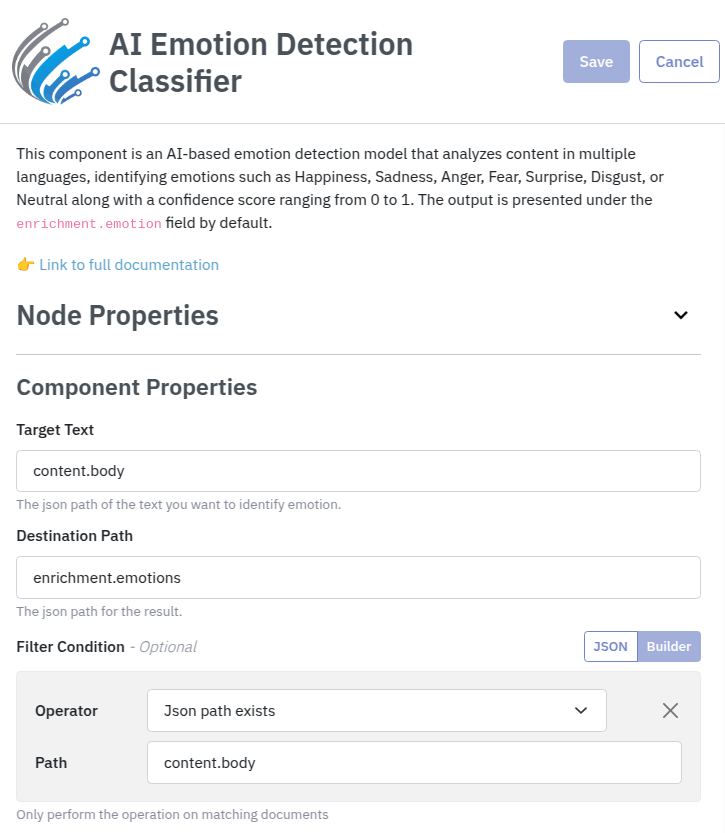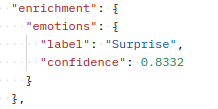AI Emotion Classification
Unlock Emotional Insights from Social Media Content
The AI Emotion Classifier is designed to analyze and detect emotional tones within social media content, enabling businesses to understand audience sentiment, engagement patterns, and public perception at scale. This model efficiently categorizes emotions such as Happiness, Sadness, Anger, Fear, Surprise, Disgust, and Neutral, providing real-time and batch-processing capabilities for improved decision-making.
Powered by Google Gemini 2.0 Flash, It achieves a 90% accuracy rate, validated through extensive testing on widely recognized benchmark datasets, leveraging advanced NLP techniques to analyze text, emojis, and contextual cues.
Adding to your Dynamic Pipeline
This component can be seamlessly integrated into your Dynamic pipelines through the "AI Emotion Classifier" component. It requires the following fields for configuration:
Destination Path (Required): The "enrichment.emotions" field is designated to store the emotions output. This output includes a emotion label—one of these possible labels (Happiness, Sadness, Anger, Fear, Surprise, Disgust, or Neutral)—alongside a confidence score ranging from 0 to 1, reflecting the model's certainty for each emotions detected.
Target Text (Required): This is the metadata field containing the input text for emotions analysis. By default, it’s set to content.body, but any field containing relevant text can be used.
If the Gemini Model encounters safety issues with certain content, you will find that Gemini API failed to generate output.
Dynamic Pipeline Configuration Example
The following example shows a dynamic pipeline configuration for the AI emotions Classifier component. If Unify is the preceding step in your pipeline, you can set it up as follows:
- content.body from the input document is specified as the Target Text for the AI emotions Classifier.
- enrichment.emotions is designated as the Destination Path for storing the AI emotions Classifier output.

Sample Example Output

Compatible Languages
The Micro Classifier supports content in multiple languages. When the input text is in a language other than English, the component automatically detects the language and performs the sentiment classification accordingly. Sentiment label will be provided in English. The language coverage is continuously improved as this component uses Google Gemini 1.5 Flash in the back end. Referring to https://ai.google.dev/gemini-api/docs/models/gemini#gemini-1.5-flash the language coverage is:
| Language | Language ID (ISO-639) |
|---|---|
| Arabic | ar |
| Bengali | bn |
| Bulgarian | bg |
| Chinese | zh |
| Croatian | hr |
| Czech | cs |
| Danish | da |
| Dutch | nl |
| English | en |
| Estonian | et |
| Finnish | fi |
| French | fr |
| German | de |
| Greek | el |
| Hebrew | iw |
| Hindi | hi |
| Hungarian | hu |
| Indonesian | id |
| Italian | it |
| Japanese | ja |
| Korean | ko |
| Latvian | lv |
| Lithuanian | lt |
| Norwegian | no |
| Polish | pl |
| Portuguese | pt |
| Romanian | ro |
| Russian | ru |
| Serbian | sr |
| Slovak | sk |
| Slovenian | sl |
| Spanish | es |
| Swahili | sw |
| Swedish | sv |
| Thai | th |
| Turkish | tr |
| Ukrainian | uk |
| Vietnamese | vi |
Updated 7 months ago
